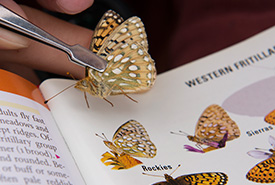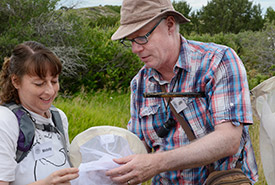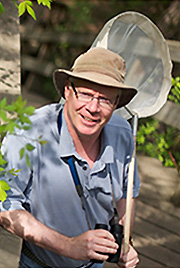Why not count some butterflies?

Identifying species at a CV butterfly count in Waterton (Photo by NCC)
This summer, my 12-year-old son Benny and I enjoyed helping out with two butterfly themed events for Nature Conservancy of Canada (NCC) in Alberta; one at the Ghost Horse Hills, and the other at the Weston Family and Bruder properties along the Waterton Park Front. Benny loves chasing butterflies, and I’ve been obsessed with them since I was half his age. The events were fun, the butterflies were plentiful and the folks we worked with were glad for our help.
The obvious question, though, is: why bother with a butterfly count?
I suppose the obvious answer is that NCC protects land, and land is more than just water, rocks and soil. Particular areas are chosen because of the things that live there, especially when the overall effect is to give the impression ecological specialness or uniqueness. The obvious thing to do, once you have decided to protect something, is to figure out what you need to protect — to inventory it, so to speak.
Traditionally, we describe the ecology of a landscape in terms of plants (especially big, obvious trees and bushes), birds and mammals, after which we tack on a list of various living things that are rare or endangered in some fashion. Go to the website for any park or protected area, and you’ll see what I mean. Ecologists, however, know perfectly well that trees, shrubs and warm-blooded vertebrates do not an ecosystem make.
Butterflies help fill in the picture. To start with, they tell you something about the plants, since each species of butterfly needs particular plants as caterpillars and other plants for nectar once the caterpillars become adult butterflies. Great places for butterflies combine lots of “host” plants, lots of nectar flowers and some open spaces as well, since Canadian butterflies generally need sunshine in order to stay active. All of the NCC properties we visited had these characteristics.
If you follow butterflies through their lives, however, you will find that they spend most of their time as eggs, caterpillars and pupae, and that adult butterflies are on the wing for only a short time each year.
Some species, like the mourning cloak, hibernate as adults and can live almost a full year once they emerge from the pupa. Others, such as common alpines, live only a few days as adults and the entire flight season for the alpines in a particular place will last only a week or two.

John Acorn at a CV butterfly count in Waterton (Photo by NCC)
So a one-day butterfly survey, no matter how well executed, gives data on only one slice of the local butterfly pie, even though it does contribute to a biotic inventory of a particular site. That’s why many butterfly enthusiasts make weekly counts in the same area (sometimes called “Pollard Walks” after a famous British butterfly conservationist), thereby covering all of the local species as they emerge from spring to fall, as well as recording the migrants, wanderers and second or third broods of some species.
I do two such counts in the Edmonton area (including the Wagner Natural Area, where NCC is involved), and I now have data going back to 1998. I can’t help but think how great it would be if some NCC volunteers were to begin collecting weekly (or biweekly, I suppose, but how could anyone resist counting butterflies for two weeks at a time?) survey data of this kind.
Butterfly scientists are just now beginning to see how good data from a variety of sites can help answer questions about climate and land use changes and their effects, shifts in the ranges and flight seasons of well established butterflies and the effects of newly imported species (the word “invader” is ecologically inappropriate, in my opinion) on the overall butterfly fauna.
Citizen science databases such as eButterfly collect and analyze such data, and NCC butterfly specialists such as Jaimee Morozoff have already begun contributing to these projects. Not only that, if you don’t know what species of butterfly you have found there are people (like me) who vet submissions to eButterfly and identify species based on photographs, descriptions, field sketches and specimens. You can learn as you go.
So by all means get out there and document the plants, the birds, the mammals and the species of conservation concern. But if you want a real challenge, a great learning opportunity and a way to contribute useful data to both NCC and the science of butterfly biology, consider visiting your nearest NCC property and starting your own “Pollard Walk.”
After hundreds of such walks and thousands of individual butterflies counted, I can vouch that it will be time well spent.


